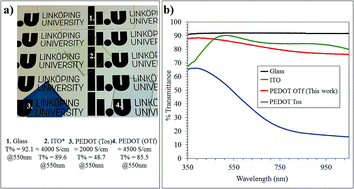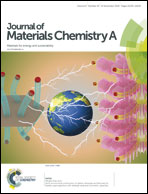Vapor phase synthesized poly(3,4-ethylenedioxythiophene)-trifluoromethanesulfonate as a transparent conductor material†
Abstract
Inorganic transparent conductive oxides have dominated the market as transparent electrodes due to their high conductivity and transparency. Here, we report the fabrication and optimization of the synthesis of poly(3,4-ethylenedioxythiophene) trifluoromethanesulfonate via vapor phase polymerization for the potential replacement of such inorganic materials. The parameters and conditions of the polymerization were investigated and an electrical conductivity of 3800 S cm−1 and 4500 S cm−1 after acid treatment were obtained while maintaining an absorbance similar to that of commercial indium tin oxide. This increase in electrical conductivity was rationalized experimentally and theoretically to an increase in the oxidation level and a higher order of crystallinity which does not disrupt the π–π stacking of PEDOT chains.



 Please wait while we load your content...
Please wait while we load your content...